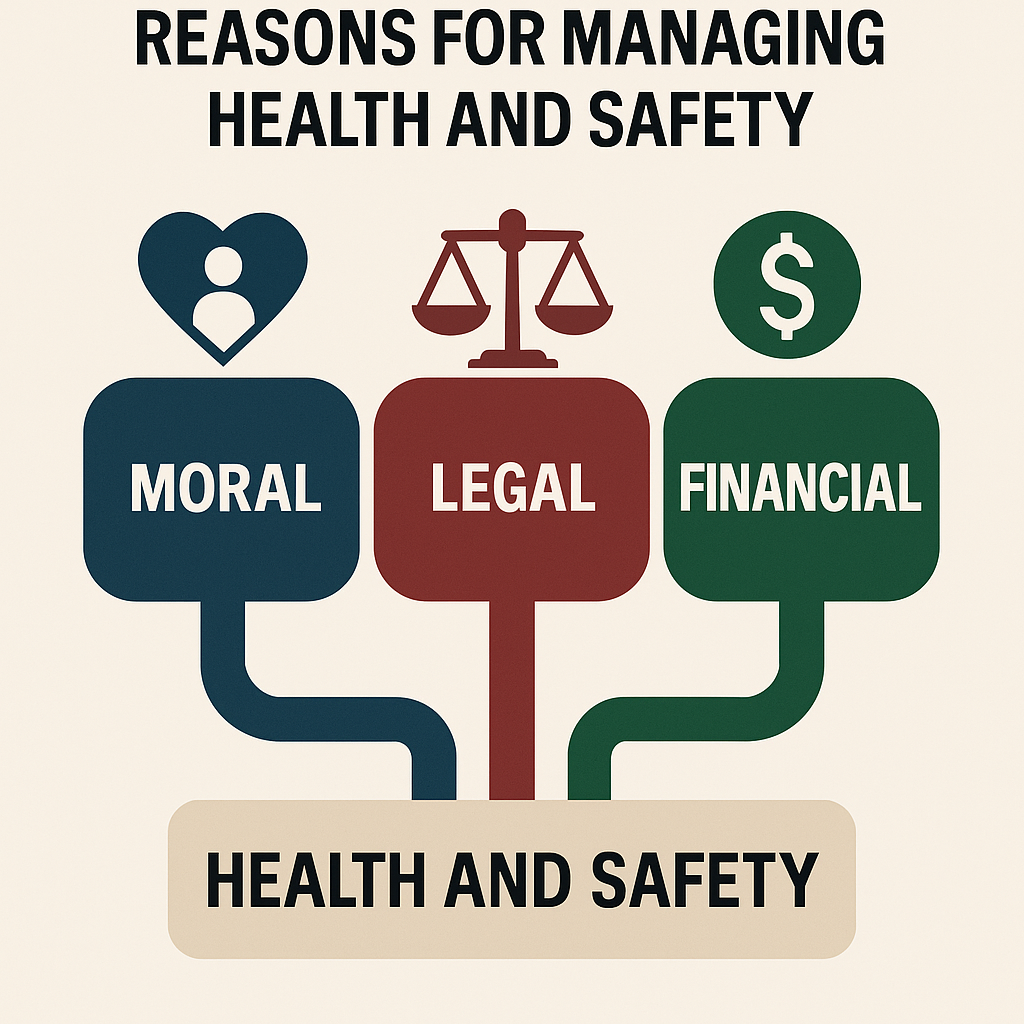
Moral, Legal and Financial Reasons for Managing Health and Safety
Workplace health and safety is a critical responsibility for all employers. Effective health and safety management is not just about ticking legal checkboxes—it reflects an organization’s ethics, financial priorities, and moral obligations. In this article, we delve deep into the three core reasons why businesses must manage health and safety: moral, legal, and financial.
What Are the Reasons for Managing Health and Safety?
Every employer must ensure a safe and healthy working environment for employees, contractors, visitors, and the general public. The reasons for this responsibility are classified into three major categories:
- Moral – The ethical duty to prevent harm.
- Legal – The obligation to comply with national and international laws.
- Financial – The cost-saving benefits of preventing accidents and ill-health.
Each reason is interconnected, forming the foundation of a robust health and safety culture.
Moral Reasons for Managing Health and Safety
Understanding the Moral Duty
Moral reasons stem from a humanitarian concern for the well-being of workers. Every individual deserves to go to work and return home safely. Employers have a moral obligation to:
- Respect the life and dignity of employees.
- Prevent unnecessary suffering caused by accidents and illnesses.
- Promote a culture of care, compassion, and responsibility.
Examples of Moral Failures:
- A worker falls from scaffolding because no guardrails were provided.
- Employees exposed to harmful chemicals without proper PPE develop chronic illnesses.
- A stressed-out employee commits suicide due to a toxic workplace environment.
These are not just failures of procedure—they’re failures of humanity.
How Moral Responsibility Impacts the Organization:
- Builds trust between workers and management.
- Increases employee engagement and loyalty.
- Enhances the reputation of the organization.
- Reduces turnover and absenteeism.
Failing morally can lead to long-term reputational damage and the breakdown of workplace culture.
Legal Reasons for Managing Health and Safety
Legal Frameworks and Regulations
Every country has specific laws that employers must follow. These laws define responsibilities, set safety standards, and enforce penalties for non-compliance. In many jurisdictions, these laws are influenced by international conventions such as the ILO (International Labour Organization) standards.
Examples of Legal Frameworks:
- UK: Health and Safety at Work Act 1974
- India: Factories Act 1948, OSH Code 2020
- UAE: OSHAD-SF, Ministry of Labour directives
- Global: ISO 45001:2018 – Occupational Health & Safety Management Systems
Legal Duties of Employers Include:
- Ensuring the health, safety, and welfare of all workers.
- Conducting risk assessments and implementing control measures.
- Providing training and supervision.
- Reporting accidents and dangerous occurrences.
Legal Duties of Employees Include:
- Taking care of their own health and safety.
- Following safe work practices.
- Reporting unsafe conditions.
Legal Enforcement and Penalties:
If organizations fail to meet legal requirements, enforcement agencies can:
- Issue Improvement Notices (correct unsafe conditions).
- Serve Prohibition Notices (stop dangerous work immediately).
- Impose fines, sanctions, or imprisonment.
- Initiate civil lawsuits for compensation by injured parties.
Why Legal Compliance Matters:
- Protects organizations from costly litigation.
- Avoids regulatory inspections and penalties.
- Builds legal credibility with stakeholders and clients.
- Ensures fair treatment and protection of workers’ rights.
Legal responsibility is not optional—it is a binding requirement that every employer must fulfill.
Financial Reasons for Managing Health and Safety
The Financial Impact of Poor Safety
Contrary to the belief that health and safety is a “cost burden,” effective safety management is an investment that saves money and protects profits. Accidents and illnesses can result in both direct and indirect costs.
Direct Costs Include:
- Fines and legal fees.
- Medical treatment and compensation payouts.
- Repair or replacement of damaged equipment.
- Insurance claim costs.
Indirect Costs Include:
- Downtime and lost productivity.
- Retraining replacement staff.
- Increased insurance premiums.
- Damaged reputation leading to loss of clients.
- Decreased employee morale and motivation.
Often, indirect costs are five to ten times higher than direct costs—and not always covered by insurance.
Cost of Accidents – Real-Life Examples:
- A minor hand injury can cost over $10,000 in total losses.
- A workplace fatality can cost millions in legal, reputational, and compensation terms.
- A fire caused by electrical failure could result in business closure.
Benefits of Safe Workplaces:
- Reduced absenteeism and sick leave.
- Increased operational efficiency.
- Lower turnover and recruitment costs.
- Enhanced client trust and investor confidence.
Safety isn’t just about compliance—it’s about keeping the business sustainable and competitive.
The Interconnection of Moral, Legal, and Financial Factors
| Reason | Focus Area | Organizational Benefit |
|---|---|---|
| Moral | Ethical responsibility | Improved workplace culture |
| Legal | Compliance with laws | Reduced legal risk |
| Financial | Cost reduction and risk mitigation | Increased profitability |
Failing in one area often leads to consequences in the others. For example:
- An accident caused by negligence (moral failure) leads to legal prosecution and financial loss.
- Ignoring safety laws (legal failure) can result in a worker death, causing moral outrage and financial ruin.
An integrated approach to safety is not just ideal—it’s essential.
Proactive Safety = Long-Term Business Success
Organizations that invest in safety create a sustainable future. Safety-conscious companies:
- Attract and retain top talent.
- Build long-term client relationships.
- Innovate safer processes and improve efficiency.
- Set industry benchmarks and gain competitive advantage.
Key Takeaways
- Moral reasons emphasize the ethical duty to protect lives.
- Legal reasons outline the regulatory and statutory requirements.
- Financial reasons highlight the real business benefits of good safety management.
- All three reasons are interconnected and must be addressed together for maximum impact.
How to Pass the NEBOSH IGC in Your First Attempt: Study Plan + Resources
NEBOSH IGC Career Guide: Jobs, Salaries & Growth Opportunities (2025)
NEBOSH IGC vs OSHA 30-Hour: Which is Better?
30 NEBOSH IGC Interview Questions & Answers (2025)
NEBOSH IGC vs OSHA 30-Hour: Which is Better for Construction Safety?
Conclusion
Managing health and safety is more than a compliance task—it’s a core value that must be embedded into every business process. The moral duty to protect, the legal requirement to comply, and the financial incentive to save all point to one universal truth:
A safe workplace is a successful workplace.
























